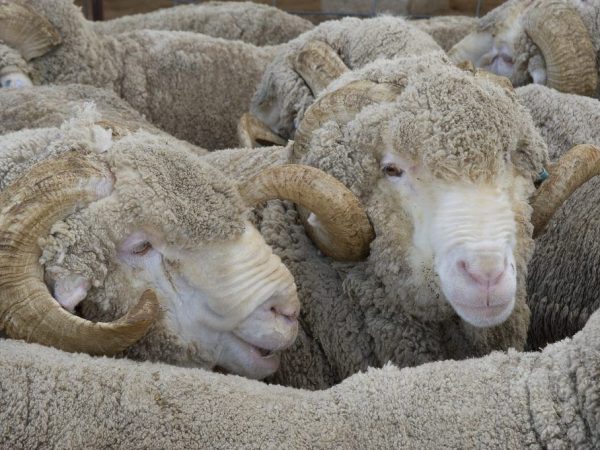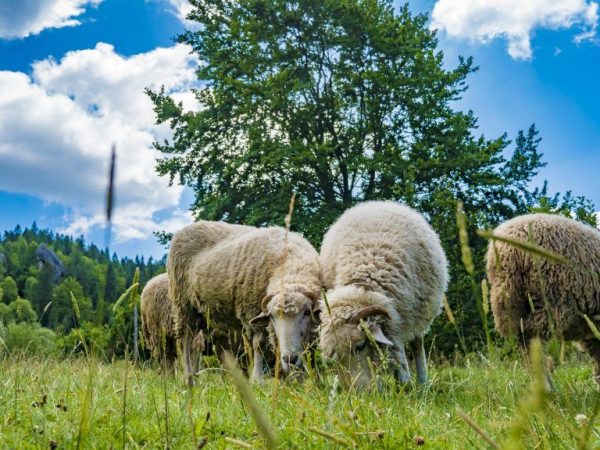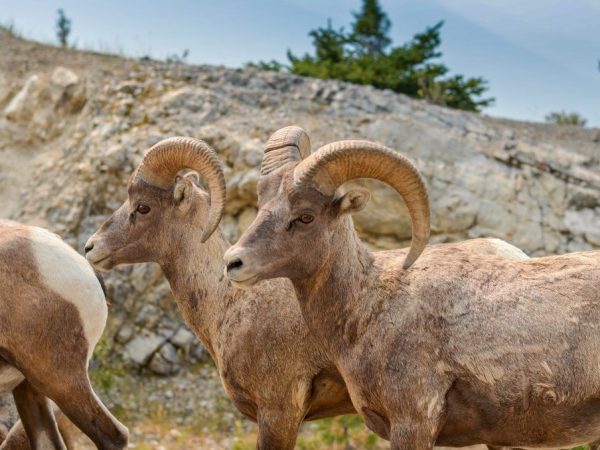Wild and domestic sheep
Sheep are ruminants from the artiodactyl order, the bovine family, the ram genus. They live in the wild only in the northern hemisphere. They inhabit mainly mountainous areas. The species was domesticated more than 8000 years ago. Sheep are bred for the sake of meat, lard of valuable sheepskin and fur. Delicious cheese is obtained from their milk. Today, sheep breeding is one of the leading areas of agriculture in a number of countries.

Description of rams
General description of the species
The word “ram” came into Russian from Greek, where “bario” means “small livestock”. Wild and domestic rams are very similar to each other. The appearance may differ depending on the species and breed, but animals have many similarities and similar biological characteristics:
- body length - 1.4-1.8 m;
- weight - from 25 kg to 220 kg;
- height - 65-125 cm;
- head with an elongated and slightly pointed muzzle, often with a hunchback nosed, completely covered with hair;
- lips are thin and very mobile;
- the forehead is decorated with long twisted horns, in males they are more massive than in females, some domestic breeds are hornless;
- the eyes are located on the sides of the head, the pupils are rectangular, the angle of view in this species is 270-320 °, animals can see what is happening behind their backs without turning their heads, binocular vision is poorly developed;
- the sense of smell is well developed, which males use to recognize females during estrus, and sheep - to recognize newborn lambs;
- hearing is excellent, allows you to hear each other and the approach of enemies at a great distance;
- there are 32 teeth in the jaws of domestic rams, in wild ones the number of teeth can vary;
- the taste is well developed, the animal chooses and eats the sweet and sour plant, ignores the bitter;
- the body is cylindrical, covered with thick wool;
- legs are even and high, adapted to walking on plains and mountains;
- tail 7-15 cm long, shorter in domestic sheep;
- the coat is curly and long (5-20 cm), consists of a guard hair and an undercoat, fine-wool breeds have only an undercoat, males may have a fluffy collar on their necks;
- coat color from white to black with different shades of gray and brown.
Sheep are characterized by pronounced sexual dimorphism. Males (rams) are much larger than females (sheep). The horns of males are large, can reach almost 2 m in length and look very impressive in the photo. Females' horns are not so long and thick; some domestic breeds do not have them at all.
Lifestyle, behavior and reproduction
Rams live in groups, a herd of sheep can number from 10 to several hundred individuals. If the lamb is isolated, it experiences stress, often gets sick and dies quickly. The leader in the herd is the largest ram, the hierarchy is strict, determined by the size of the horns.
The described animals feed on various types of grasses, shrubs, tree leaves, berries, in winter they can eat moss, lichens. Sheep are unpretentious in food, wild species are able to survive high in the mountains, in deserts, where the food supply is scarce. Individuals are active in the morning and evening, sometimes at night, and during the day they rest in the shade.

Sheep live in groups and feed on grasses
A complex signaling system helps sheep communicate. Sounds include bleating, snorting, grunting, and sometimes animals even squeak. The male sheep makes loud trumpet sounds during the breeding season. Females may grunt during childbirth. Bleating is the main signal of communication, primarily between cubs and parents. Also, with the help of bleating, animals call each other in the herd.
Sexual maturity of sheep and lambs occurs at 1.5-3 years, in wild species later than in domestic ones. The breeding season in the southern regions begins at the end of July, in the north in October or November. The rams arrange fights among themselves for the female, so that she understands which of them is the most worthy. Only the strongest representatives mate. During this period, males are very dangerous.
Pregnancy lasts 5 months. The female wild ram gives birth to 1-2 lambs, domesticated - 2-3, in some cases and more. From the first minutes, the cub stands on its legs and very quickly applies to the nipple. In the first days, females with offspring hide in secluded places, but after a week they go out to pasture to other sheep. Lambs feed on milk for up to 3-4 months, in six months the lamb is already completely independent.
Wild rams
There are many varieties of rams in nature. Their habitat occupies almost the entire northern hemisphere. Today, the largest number of animals is observed in the mountainous regions of the Middle East, Turkey, Afghanistan and Pakistan. You can find them in the region of the Tibetan ridge, in Altai, the Caucasus, in the Tien Shan mountains, in the West Siberian plain. Sheep live in North America, from Mexico to Canada and Alaska. The wild species in Europe are believed to have become extinct about 3,000 years ago. Now there are only feral domestic species in Greece, Spain, Malta, Cyprus. But not all zoologists agree with this.
A unified classification of wild species has not been developed. Some researchers take into account the properties of the exterior, others pay attention to the number of chromosomes. In rams, it ranges from 50 to 58 pairs. Moreover, even in one individual in different cells, it may differ. Species with different numbers of chromosomes can be crossed and produce fertile offspring. Sometimes the steppe Turkmen sheep and musk ox are mistakenly considered to be these species. In fact, these animals belong to the bovine family.

Varieties of wild rams
To date, the following types of wild sheep are known:
- European Mouflon. Lives in Sardinia, Corsica, in some southern European countries. It weighs 50 kg, has a height of 125 cm, in summer it has a red color, and in winter it is chestnut, with a white belly. In males, the horns are about 65 cm long, in a triangular section, in females they are practically absent.
- Asian Mouflon. Lives in India, Iran, Central Asia, Transcaucasia, Turkey. It weighs about 80 kg, its height is within 90 cm, its length is 150 cm. The horns of the males are twisted, the girth at the base is almost 30 cm, in females they are much smaller. The color in summer is red with a brown or yellow tint, in winter it is dark. On the back there is a characteristic dark stripe with white guard hairs.
- Cypriot Mouflon. An almost extinct wild ram that lives in Cyprus. The animals weigh 25-35 kg, their height is within 65-75 cm, the length of their body is about 110 cm.The ram's shaggy head is decorated with twisted horns about 50-60 cm long. The color is from dark brown to golden, the muzzle and tips of the hooves are white, there is a black stripe on the back.
- Urian. Lives in the mountainous regions of India, Afghanistan, Pakistan, Iran, Kazakhstan, Central Asian countries. Weight - around 85-90 kg, height about a meter, length - 145-151 cm, Horns are thick, up to a meter in length, thickness at the base is more than 30 cm, twist into a spiral. The fur is light brown in summer, darkens in winter. Urians and Mouflons can interbreed with each other, producing fertile offspring.
- Argali. Lives in the Central regions of Asia, in the east of Siberia. The largest of all wild rams. It weighs 65-120 kg, its height is 90-120 cm, and its length is about 2 m.Huge horns in males can reach 190 cm. Coat colors range from sandy to gray and brown. In nature, there are 9 subspecies of Argali.
- Bighorn sheep. Its habitat corresponds to our eastern regions of Siberia. The weight of the animal is from 60 kg to 150 kg, the mass of females is 33-65 kg. Growth - a little over a meter. The horn is twisted into a ring, smooth, without transverse notches, its length is 1.3-1.8 m. Both ram and sheep have horns. The fur on the back is dark brown, in sharp contrast to the white belly.
- A ram of the Bighorn sheep species. Lives in Canada, USA, all the way to the California coast. Weighs 70-140 kg (female - 50-90 kg). The horns of the males are more than a meter, twisted into a ring, the females are sickle-shaped. The coat is sandy-brown, brown or black. There is a mountain and desert bighorn species, the desert is a dwarf reduced version of the mountain.
- Dall's Thin-Legged Ram. Another American species, which is named after its discoverer. Lives in the north of the continent. The weight of the animals is about 140 kg, the length is 1.4-1.6 m. The horns are curled, more than a meter in length. There are two subspecies of sheep: with white and gray wool.
Wild ram and sheep prefer to live in a limited area, with an area of about 30-40 km, like the ibex. In winter, the mountain sheep descends from the peaks to the valleys, where there is more food. During the breeding season, the herd of sheep is small, numbering about 30 individuals. In winter, animals gather in large groups of 500-1000 animals.
Domestic sheep
Mouflons are considered the ancestors of all domestic sheep. They have similar external data and the same number of chromosomes. Previously, the origin was also deduced from the Urians, but now this theory has been discarded. People have been breeding this species for more than 8000 years. They have taken a firm place in the culture of many peoples. Everyone knows the ancient Greek myths about the golden fleece and the Argonauts. Aries is included in the zodiac constellations. The ancient Egyptian god Amon and the Phoenician god Baal were depicted in the form of a sheep. Even in modern computer games ARK and M8, this character is present.
The stone ram was often used to decorate gravestones in Armenia and the Middle Eastern countries. Ancient warriors covered shields with sheep skins and wrote to their enemies: "You will fall, my sword will kill you!" Archaeologists found animal skulls on excavations of pagan temples and altars in different parts of the Earth. Sheep breeding is now very popular where Islam is widespread. This fact can be connected with the fact that this religion prohibits the use of pork.
The lifestyle of domestic and wild sheep is similar. Both those and others gather in herds. In the groups, the hierarchy is clearly expressed: the head is the male, whose large ram head is decorated with the most powerful horns. Animals prefer to graze in the morning and evening hours. The appearance depends a lot on the breed. The following groups are distinguished (taking into account productivity):
- Meat. These breeds quickly gain weight, they can reach a mass of over 200 kg, their meat is low-fat, and the yield after slaughter is high.
- Meat and wool. In addition to good meat characteristics, lambs have thick and long fur.
- Meat products. These rams are heavy and quite fatty meat.
- Greasy. The main characteristic of such breeds is a developed fat tail in the back of the body, from which up to 5-6 kg of fat can be obtained.
- Woolen. These lambs are bred for the sake of wool, their weight is small, but the hair is very long and thick, after a haircut and hairstyle they get several kilograms of fleece.
According to the quality of the fleece, sheep breeds are divided into:
- Fine-wooled. These animals have only an undercoat, its length can exceed 15-20 cm.
- Semi-fine wool. They have guard hair, but it is not too thick and rather soft.
- Coarse-haired. These sheep have thick, coarse and elongated guard hairs.
Fine-wooled breeds - suppliers of elite, high-quality wool, from which expensive fur products are made. A good pillow, a quilt, a mattress topper, a jacket, a fur coat are obtained from the wool of semi-fine-wool sheep.Mattresses, slippers, felt boots, insoles, horse saddle pads are sewn from coarse wool, carpets and other products are made. Animal skins are also used. They can be used to make astrakhan hats, like Shevchenko's in a self-portrait, fur coats, sheepskin coats and other leather things. They say that sheep's wool and skins have a healing effect for radiculitis, arthritis, and other useful properties.
According to the method of breeding, sheep breeds are divided into primitive or aboriginal and cultural. Primitive breeds have been bred by methods of folk selection for centuries. Cultural ones have appeared in the last 100-200 years; scientific approaches were used in their creation. There are dozens of varieties in the world. Here are the most popular ones:
- Romanovskaya;
- Texel;
- Suffolk;
- Dorper;
- Cameroon;
- Karakul;
- Tashlinskaya;
- Tashlinskaya;
- Edilbaevskaya;
- North Caucasian;
- Kuibeshevskaya.
There is a large number of domestic sheep in China. The breeding belt extends to Australia, India, Iran, New Zealand, England. Sheep are raised in the Caucasus, in the southern part of Russia, Central Asia. The breed is chosen depending on what the livestock is raised for.
Care and maintenance
A domestic thoroughbred ram is an unpretentious animal, it is easy to take care of it. The main requirements are sufficient grazing area and spacious living quarters. The flock spends most of the year in the pasture. They also arrange a corral, it can be open, with one gate, on which there is a reliable handle for closing. To graze one sheep or lamb you need 1 hectare of land. There should be a reservoir near the grazing site; the animal needs about 10 liters of water per day.

Sheep and rams need proper care
In winter, the flock is kept in a sheepfold. For 10 females with lambs, you need 40 m² of area. Tribal ram or rams are kept in separate rooms, they must be separated by partitions so that the males do not fight. The temperature in the barn should be at least 9 ° C, drafts should not be allowed: they are harmful to sheep. When a farm is being built in warm regions, heating is not provided. Good insulation should be done in cold areas.
Feeding
Feeding livestock is not difficult: they eat almost any plant. In summer, green grass is enough for them, provided that the shepherd takes the herd out to pasture for at least 13 hours a day. In winter, animals should be fed with natural food. Sheep include in the diet:
- Juicy feed: silage and root crops (beets, potatoes, carrots, etc.).
- Roughage: hay and straw.
- Concentrated feed: cereals, corn, peas and other legumes, bran, cake.
The rams are given three times a day. Evening meals shouldn't be too satisfying. Before pouring concentrates into the nursery, the animals must be watered. The amount and proportion of food depends on the purpose for which the animals are raised. For good coat growth, grasses and hay should prevail in the diet. When fattening for slaughter, they give concentrates, oilcakes, leguminous hay.
Mating is planned for late spring or early autumn. It is advisable to cross individuals within the same breed. 2-3 males are allowed to breed, and rams that are unsuitable for mating are sterilized. Castration is carried out before puberty, at 5-6 months.
5 months after mating, small lambs appear. A female domestic ram can give birth to 2-3 cubs at the same time. The process lasts about half an hour, the afterbirth is easily separated. If childbirth is difficult, the females are injected with oxytocin, the fetus is pulled out with their hands, but this is rarely necessary. The ewes feed the lambs for up to 2-3 months, after which the young are transferred to adult feed.
If the females are milked, the young are weaned earlier. But too fast weaning and transfer to adult feed can be harmful, lambs develop dyspepsia, ketosis, kidney failure, and weight gain indicators drop. Often weaned lambs are affected by worms (annelids and tapeworms), intestinal infections.
Breeding benefits
A herd of domestic sheep pays for itself very quickly. The cost of feed is minimal, the sheep grows very quickly, young animals can be sent for slaughter as early as 7-8 months. You can get several kilograms of wool from wool breeds. Haircuts are done twice a year. A sheep farm can start with several dozen individuals, and after a couple of years the flock will grow to hundreds and even thousands. As in any agricultural business, sheep breeding has its pluses and minuses, but there are still more positive moments. There are huge benefits from animals, you can get the following types of products:
- meat;
- sheep fat;
- wool;
- skin;
- milk, butter and cheese;
- manure for fertilization.
How much is a lamb worth? The price depends largely on the breed and the purpose of the acquisition. You can buy a live adult sheep for slaughter at 110-200 rubles per kilogram of live weight. A small young lamb can cost 2000-4000 rubles. It's no secret that the most expensive breeds are Merino. Elite fine wool sheep for breeding are sold for several hundred or even thousands of dollars. It is best to buy sheep from specialized farms at the age of 3-4 months.

